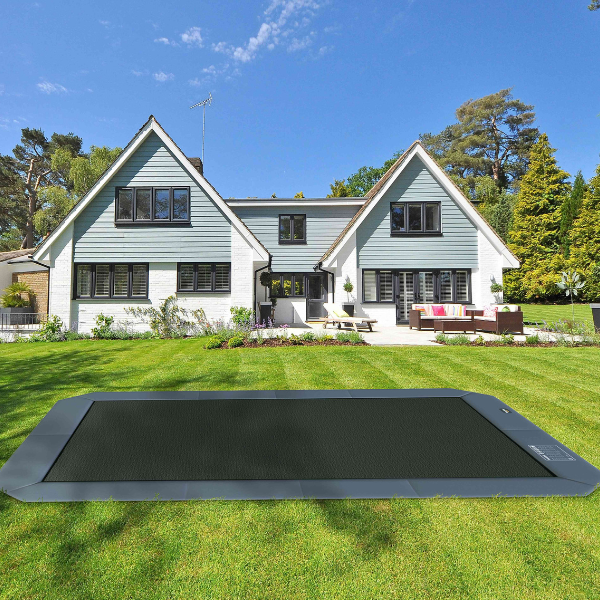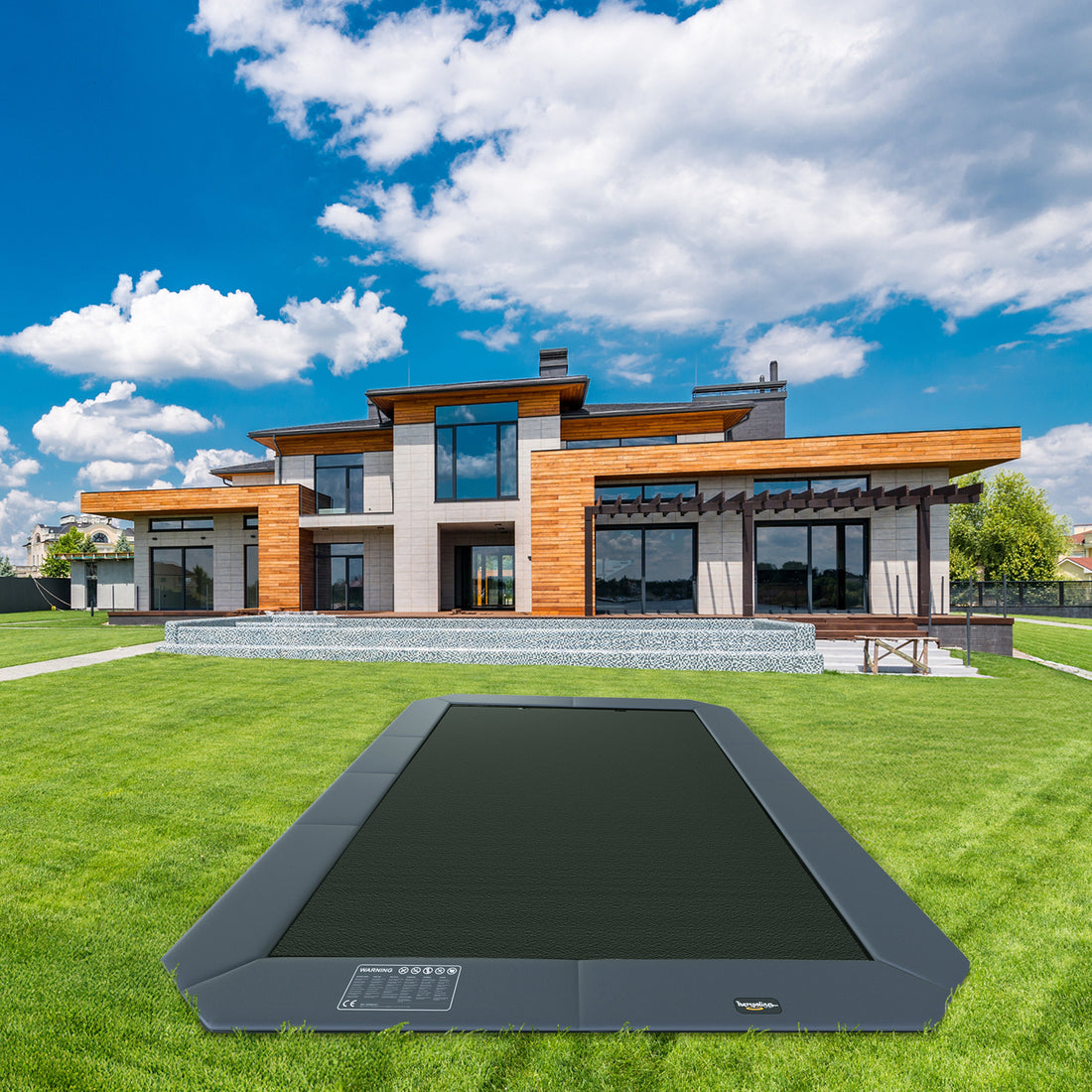Choosing the right ground surface is one of the single most important decisions you’ll make before an in-ground trampoline goes into your yard. The soil and base under the trampoline affect safety, drainage, longevity, and how often you’ll need to perform maintenance. Today, we’re sharing a practical, homeowner-friendly guide that breaks down the pros and cons of common surfaces, giving you clear steps to prepare a stable, long-lasting base for an in-ground trampoline installation.
Why the Ground Surface Matters
The ground under an in-ground trampoline is more than just a hole in the yard. It supports the frame, affects how water drains away, and plays a major role in preventing tilt, sinkage, and rust. A poorly chosen or prepared surface can lead to standing water, frame corrosion, uneven bounce, and costly repairs. Planning the base properly during in-ground trampolines installation saves you time and money and keeps the trampoline safe for everyone.
Grass and Topsoil
Pros:
- Looks great and blends with landscaping.
-
Soft surrounding surface for casual fall cushioning.
-
Often the most budget-friendly starting point.
Cons & Considerations:
- Grass and topsoil by themselves drain slowly and can compact or rut under repeated use.
-
Water tends to pool, especially in low spots, which can lead to muddy conditions and frame corrosion.
Best practices:
If you install on grass, always add a drainage layer (gravel) at the base and consider using a geotextile fabric to separate soil and gravel. Reinforce edges with proper retaining walls or edging to prevent collapse. Regularly re-seed and compact around the rim to keep the area tidy.
Sand as a Surface
Pros:
- Excellent drainage—sand lets water percolate quickly.
-
Easy to dig and shape; forgiving to install.
Cons & Considerations:
- Sand shifts over time and can settle unevenly unless contained.
-
It may require edging or a retaining barrier to keep the pit stable.
Best practices:
If you prefer sand, use it in combination with a compacted gravel layer and geotextile fabric beneath. Contain the sand with a concrete or treated timber ring, or use a prebuilt retaining wall included with some in-ground trampoline kits. Periodically re-level the sand to prevent low spots from forming.
Clay Soil Considerations
Pros:
- Once compacted, clay can be very stable and supportive.
-
Less shifting than sand if properly prepared.
Cons & Considerations:
- Clay drains poorly and can hold water, causing muddy pits and potential frame deterioration.
-
When wet, compacted clay can become soft and unstable.
Best practices:
If your yard is clay-heavy, don’t rely on native soil alone. Excavate, install a 6–12 inch gravel bed, and add a perforated drainage pipe (French drain) routed away from the pit. A geotextile membrane will prevent the gravel from mixing with clay over time. These steps dramatically improve drainage and pit stability.
Rocky or Gravelly Ground
Pros:
-
Natural drainage and firmness — often a very stable base.
-
Less risk of pooling water if the rocks are well-graded.
Cons & Considerations:
-
Excavation can be hard work or require machinery.
-
Sharp rocks need to be removed or covered to prevent damage to padding and frames.
Best practices:
If your yard has large rocks or gravel, remove boulders and sharp stones from the immediate pit area. Lay a compacted, graded gravel base (clean, angular gravel like 3/4" crushed stone) and top with a geotextile fabric.
Mixed Soil Solutions: Create an Ideal Base
If your yard doesn’t have a perfect surface, you can engineer one. A common, reliable approach is:
- Excavate the pit to the dimensions required by the trampoline manufacturer.
- Line the pit with geotextile fabric to separate soil from the drainage layer.
- Place and compact 6–12 inches of coarse gravel (crushed stone) as a base.
- Install perforated drainage pipe (French drain) around the pit perimeter, sloping it to a safe outlet.
-
Add a compacted layer of sand if desired for a smoother final bed, contained by edging.
This mixed approach to the in-ground trampoline installation process addresses stability, drainage, and long-term maintenance in nearly all soil types.
When to Consult a Professional Trampoline Installer
Some yards benefit from a pro assessment during an in-ground trampoline installation, especially if you have:
- A high water table or frequent pooling after storms.
- Very rocky ground or difficult excavation conditions.
-
A steep slope near the installation area that requires grading or retaining walls.
Landscape contractors and drainage specialists can design a reliable system (sump, pump, or tie-in to existing stormwater) for your yard. Professional help can add cost up front, but it pays off by preventing soil movement, frame corrosion, and uneven settling.
Final Thoughts
Good in-ground trampoline installation starts beneath the surface. Choosing the right ground surface and preparing a proper base protects your investment, improves safety, and reduces the need for future repairs.
If you’re ready to plan your in-ground trampoline project or want product recommendations and installation support, visit in-groundtrampolines.com and explore our kits, drainage accessories, and professional installation options.
Frequently Asked Questions
1. What type of ground is best for installing an in-ground trampoline?
A well-prepared gravel base (with geotextile fabric and drainage) is best because it provides drainage, load-bearing support, and longevity.
2. Can I install an in-ground trampoline on grass?
Yes, and you should also add a drainage layer (gravel) and a fabric liner. You can also prevent edge erosion by adding a retaining system.
3. Is sand a good surface for in-ground trampolines?
Sand drains well and is easy to work with, but it shifts over time. Use sand only with proper containment and a compacted gravel sub-base for long-term stability.
4. Can I install an in-ground trampoline on clay soil?
You can, but clay requires extra drainage measures (gravel base, French drain) because clay holds water and can become unstable when wet.
5. What about rocky or gravelly ground?
Rocky and gravelly ground can be excellent due to natural drainage and firmness. Remove large boulders, clear sharp stones, and add a compacted clean gravel layer for the best results.

